We need your consent to use the individual data so that you can see information about your interests, among other things. Click "OK" to give your consent.
ASTM E1018-09(2013)
Standard Guide for Application of ASTM Evaluated Cross Section Data File, Matrix E706 (IIB)
STANDARD published on 1.6.2013
The information about the standard:
Designation standards: ASTM E1018-09(2013)
Note: WITHDRAWN
Publication date standards: 1.6.2013
SKU: NS-40147
The number of pages: 8
Approximate weight : 24 g (0.05 lbs)
Country: American technical standard
Category: Technical standards ASTM
The category - similar standards:
Annotation of standard text ASTM E1018-09(2013) :
Keywords:
covariance matrix, cross section, dosimetry, ENDF, IRDF, JEF, JENDL, nuclear metrology, ICS Number Code 35.240.50 (IT applications in industry)
Additional information
| Significance and Use | ||||||||||||||||||||||||||
|
4.1 The ENDF/B library in the United States and similar libraries elsewhere, such as JEF (9), JENDL (7), and BROND (8), provide a compilation of neutron cross section and other nuclear data for use by the nuclear community. The availability of these excellent and consistent evaluations makes possible standardized usage, thereby allowing easy referencing and intercomparisons of calculations. However, as the first ENDF/B files were developed it became apparent that they were not adequate for all applications. This need resulted in the development of the ENDF/B Dosimetry File (5, 10), consisting of activation cross sections important for dosimetry applications. This file was made available worldwide. Later, other“ Special Purpose” files were introduced 4.2 Another file of evaluated neutron cross section data has been established by the International Atomic Energy Agency (IAEA) for reactor dosimetry applications. This file, the International Reactor Dosimetry File (IRDF-2002) 4.3 The application to LWR surveillance dosimetry may introduce new data needs that can best be satisfied by the creation of a dedicated cross section file. This file shall be in a form designed for easy application by users (minimal processing). The file shall consist of the following types of information or indicate the sources of the following type of data that should be used to supplement the file contents: 4.3.1 Dosimetry cross sections for fission, activation, helium production sensor reactions in LWR environments in support of radiometric, solid state track recorder, helium accumulation dosimetry methods (see Test Methods E853, E854, E910, and E1005). 4.3.2 Other cross sections or sensor response functions useful for active or passive dosimetry measurements, for example, the use of neutron absorption cross sections to represent attenuation corrections due to covers or self-shielding. 4.3.3 Cross sections for damage evaluation, such as displacements per atom (dpa) in iron. 4.3.4 Related nuclear data needed for dosimetry, such as branching ratios, fission yields, and atomic abundances. 4.4 The ASTM-recommended cross sections and uncertainties are based mostly on the ENDF/B-VI and IRDF-2002 dosimetry files. Damage cross sections for materials such as iron have been added in order to promote standardization of reported dpa measurements within the dosimetry community. Integral measurements from benchmark fields and reactor test regions shall be used to ensure self-consistency and establish correlations between cross sections. The total file is intended to be as self-consistent as possible with respect to both differential and integral measurements as applied in LWR environments. This self-consistency of the data file is mandatory for LWR-pressure vessel surveillance applications, where only very limited dosimetry data are available. Where modifications to an existing evaluated cross section have been made to obtain this self-consistence in LWR environments, the modifications shall be detailed in the associated documentation (see 5.6). |
||||||||||||||||||||||||||
| 1. Scope | ||||||||||||||||||||||||||
|
1.1 This guide covers the establishment and use of an ASTM evaluated nuclear data cross section and uncertainty file for analysis of single or multiple sensor measurements in neutron fields related to light water reactor LWR-Pressure Vessel Surveillance (PVS). These fields include in- and ex-vessel surveillance positions in operating power reactors, benchmark fields, and reactor test regions. 1.2 Requirements for establishment of ASTM-approved cross section files address data format, evaluation requirements, validation in benchmark fields, evaluation of error estimates (covariance file), and documentation. A further requirement for components of the ASTM-approved cross section file is their internal consistency when combined with sensor measurements and used to determine a neutron spectrum. 1.3 Specifications for use include energy region of applicability, data processing requirements, and application of uncertainties. 1.4 This guide is directly related to and should be used primarily in conjunction with Guides E482 and E944, and Practices E560, E185, and E693. 1.5 The ASTM cross section and uncertainty file represents a generally available data set for use in sensor set analysis. However, the availability of this data set does not preclude the use of other validated data, either proprietary or nonproprietary. When alternate cross section files are used that deviate from the requirements laid out in this standard, the deviations should be noted to the customer ofr the dosimetry application. 1.6 This standard does not purport to address all of the safety concerns, if any, associated with its use. It is the responsibility of the user of this standard to establish appropriate safety and health practices and determine the applicability of regulatory limitations prior to use. |
||||||||||||||||||||||||||
| 2. Referenced Documents | ||||||||||||||||||||||||||
|
Similar standards:
Historical
1.5.2012
Historical
1.7.2008
Historical
1.1.2010
Historical
1.5.2013
Historical
1.5.2010
Historical
1.5.2008
We recommend:
Technical standards updating
Do you want to make sure you use only the valid technical standards?
We can offer you a solution which will provide you a monthly overview concerning the updating of standards which you use.
Would you like to know more? Look at this page.


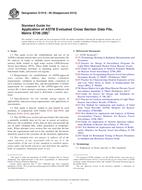
 ASTM D622-99(2012)..
ASTM D622-99(2012)..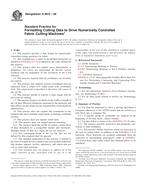 ASTM D6672-08
ASTM D6672-08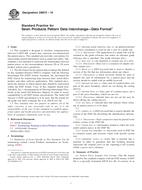 ASTM D6673-10
ASTM D6673-10 ASTM E1434-00(2013)..
ASTM E1434-00(2013)..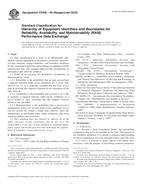 ASTM F2446-04(2010)..
ASTM F2446-04(2010)..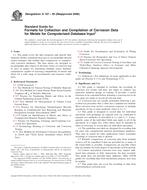 ASTM G107-95(2008)..
ASTM G107-95(2008)..
 Cookies
Cookies
